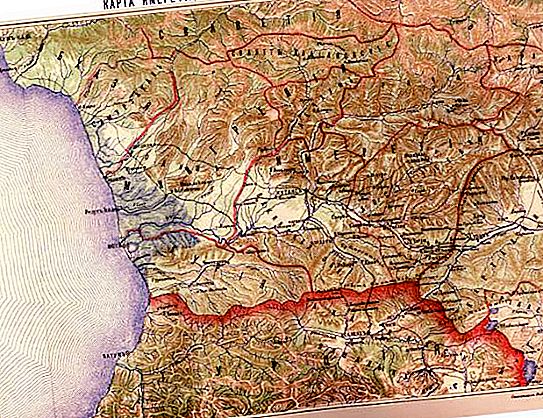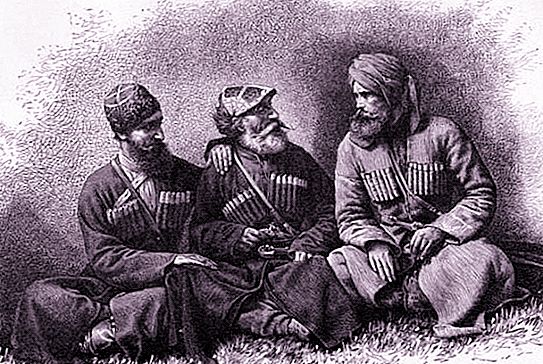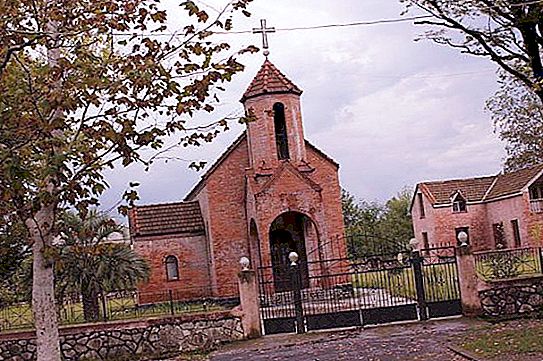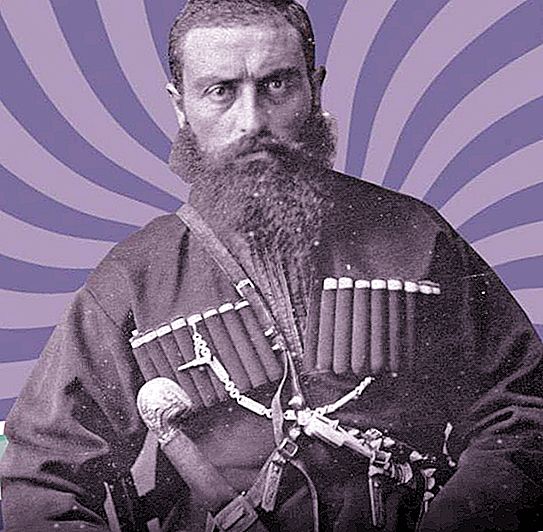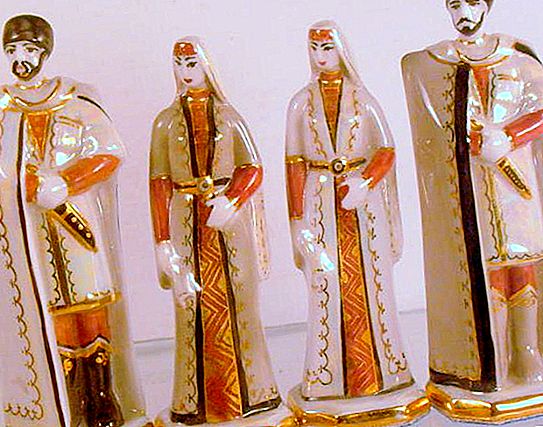Megrelian nation is a subethnic group of Georgians, mainly living in Megrelia (Samargalo), located in Western Georgia. It includes seven administrative districts: Abash, Senak (renamed Tskhakai under Soviet rule), Khob, Tsalenjikh, Chkhorotsk, Martvil (formerly Gegechkor) and Zugdidi. The region is ethnically homogeneous, with the exception of significant Russian-speaking minorities in the cities of Poti, Zugdidi and Senaki. Many megrels also live in the Gal and Ochamchir districts of the Abkhaz Autonomous Republic. Galsky is considered by many as part of Megrelia.
Location
Megrelia borders in the north with Abkhazia and the mountainous region of Svaneti. In the east and south are the Georgian provinces of Imereti and Guria, and in the west - the Black Sea. Of the total area of 4339.2 square meters. About 1260 km are river valleys and hills, and the rest are piedmont and mountain zones, mainly in the northeast (Tsalenjikh, Chkhorotsk and Marvil districts). The previously marshy coasts and valleys of the Rioni River are rich in soils, on which various crops are grown, including silk, citrus fruits and tobacco. In the lowlands, a subtropical climate with temperatures ranging from average December 4–5 ° C to July 23–24 ° C. Winters last no more than a month. In mountainous areas it is colder, especially in winter (-6 - -2 ° C in January). The annual rainfall in Megrelia is from 1, 500 to 2, 300 mm.
Demography
The population of Megrelia in 1939 officially amounted to 323, 811 people. With the addition of residents of Abkhazia and other regions of Georgia whose nationality is Mingrelian, according to some estimates, this number was approaching 500, 000 in 1941. In 1979, the official population of the region was 405, 500, or 10% of the population of Georgia. 145 thousand, or 32%, lived in 5 cities and 5 large settlements (“Dadebi”), the rest - in 370 villages. In the 1926 census, in which the Mingrelian nationality was taken into account separately, 242, 990 people. identified themselves as Mingrelians and 284, 834 claimed that Mingrelian was their native language. Since then, no official calculations have been made.
Language affiliation
Megrelian belongs to the Kartvelian (South Caucasian) languages and is not mutually intelligible with Georgian. Most former Soviet and some Western experts attribute the Mingrelian, along with the Laz, to a separate branch of the South Caucasian family, known as the Mingrelian or Zanskaya group. The Soviet scientist A. Chikobava distinguished two closely related Megrelian dialects: Western, Samurzakan-Zugdidi, and Eastern - Senak. The language does not have a written language, and although Mingrelians speak it at home, they adopted Georgian (kartuli) as a literary language. There are no language schools, books and newspapers, although there have been periodic attempts to create a literary language at the end of the tsarist and early Soviet period. Megrelian has always been one of the most described languages of the South Caucasus. Today, studies of local folklore are extensive. The Georgian language remains the destiny of business and government. The number of people who speak Mingrelian is declining, and the majority of local residents consider themselves Georgians.
Common misconception
Some argue that Mingrelians are Georgian Jews. Of course, this is not so. Georgian Jews arrived in the country in 586 BC. e. and lived throughout its territory. In 1971, their mass aliyah to Israel began, as a result of which their number decreased from 55, 400 to 3, 200 in 2010.
Who are Mingrels?
The endonym "margali", apparently, is reflected in the Greek word Μάνραλοι, which Ptolemy in the II century BC. e. designated the peoples of Colchis. The history of megrels is connected with a region that was known to the ancient Greeks and Romans as Colchis or Lazika, and to the western Georgians as Egrisi. In the XIV century. it became a separate vassal kingdom with its own dynasty of princes Dadiani called Odishi. The region began to be called Megrelia only in the 19th century. It has always been part of the wider Georgian cultural and political sphere, thanks in large part to the GOC. Sometimes, however, Megrelia was under different cultural influences, compared with the eastern Georgians (Kakhetians and Kartlis), separated from the western regions (Imereti) by the Likhi mountain range. The Greek, Roman, and Byzantine empires had a much greater influence on western Georgia. In the XVII century. the country was divided between Persia and the Ottoman Empire. The western part, including Megrelia, was under the control of the Port, and the eastern part was part of Persia. The church was also divided in two, and Megrelia, which had its own mint and customs barriers, became one of the vassal possessions until it was finally taken under the protection of Russia in 1804 as an autonomous territory. This status was eliminated after the rebellion of the Megrelian peasants in 1856-1857, who captured the capital of the Zugdidi region. In 1867, the Russian Empire officially abolished the principality. Under Russian rule, the serious problem of malaria was resolved by draining the swamps. In the period from 1918 to 1921. Megrelia was part of independent Georgia. In 1921, it became part of the USSR.
The fact that there are few conflicts in the past between them and their neighbors eloquently testifies to who the Mingrelians are. Their assimilation with the Georgians, accelerated in the 19th century under the influence of modernization, was completed after the Soviet annexation. Some indecisive attempts by local Bolsheviks to create autonomy failed. Relations between the Abkhaz and Mingrelians in the mixed southern regions of Abkhazia were overshadowed by the Georgian policy pursued by the Mingrelian Lavrentiy Beria in 1940 and 1950. The conflict between local Georgians (mainly Mingrelians) and Abkhazians arose in the 1960s and 1970s. In July 1989 there was a bloody conflict in Abkhazia caused by the demands of the Abkhaz branch; more than 20 people were killed. Mingrelians, whose appearance and language are very different from the appearance and language of the Georgians, rejected offers of political autonomy and supported the struggle for the independence of Georgia.
Settlements
Despite the high rate of urbanization, most megrels live in rural areas. The high population density in the lowlands did not significantly change the structure of settlements. The houses where Mingrelians live have their own fenced yard and outbuildings located at some distance from each other. The village can stretch for several kilometers. Previously, the settlements were called the dominant clan group. Today, residents with a common pedigree can still live in one part of the village. The houses have improved significantly compared to the primitive wooden or earthen buildings of past centuries, such as Amhara, Dzhargval and Godora. Most rural megrels today live in two-story wooden or brick houses with bedrooms on the second floor and communal rooms (kitchen, pantry) on the first. Megrelia has 5 cities. The largest of them - Zugdidi, Poti and Senaki - are a mixture of mansions and residential complexes, usually consisting of two rooms in 5-6-story buildings.
Economy
About who the Mingrelians are, says their economic activity, which, first of all, is based on agriculture. Traditionally, residents ate gomi (Panicum italicum) and, starting in the 18th century, corn, which today remains the main agricultural crop, although rich soil and subtropical climate led to the development of large-scale production of tea and citrus fruits. Georgia supplied to the USSR more than 90% of domestic citrus fruits and 97% of tea, most of which was grown in Megrelia. Pig, livestock and sheep are important. Winery, honey and cheese production are also developed in Megrelia. The family in the village remains the main economic unit. Poti is a major port. The naval base located there for a long time made the city closed.
Folk crafts
Traditionally, most families in Megrelia are weaving silk and cotton. Weaving baskets, pottery and the manufacture of wooden utensils were also developed. Highlanders make woolen carpets and clothes. Today, folk crafts continue, albeit on a much smaller scale.
Trade
Previously, Georgian Mingrelians were famous for their trading art on the entire Black Sea coast. Today, trade is controlled by the state and conducted in Western-style stores, although all urban areas have open-air markets and indoor private markets where local farmers sell their produce.
Division of labor
In the traditional patriarchal society of Megrelia, different male and female qualities are taken for granted. In the past, the gender division of labor was emphasized at birth, when boys were allowed to touch the plow or sword, and girls were allowed to touch the thimble or scissors. Agricultural responsibilities were separate, although both men and women worked in the fields. Indoor work, such as cheese making, cleaning, cooking, childcare, and weaving, were almost exclusively female responsibilities. Men were engaged in pottery, weaving baskets and making kitchen utensils, but the woman - and still is considered so - is the mistress of the house. Today, the weaker sex is still doing housework, while men are doing home repairs, helping to make purchases and, to some extent, look after the children. Girls before marriage perform light housework. The increase in the number of employed women indicates their equality at home.
Land tenure
In the Soviet period, land in Megrelia belonged to the state in the form of collective farms. Small private landholdings, orchards and vegetable gardens were allowed, and a lot of time was spent on agricultural activities. After the change of power in Georgia, collective farms were voluntarily disbanded, and the land privatized.
Kinship
The most important family relationship group here is extended family household. Mehrels traditionally value their origin and surname highly. Each genus has its patron and sign. Megrels of their surnames end with - (a) I, -ua and -ava. The society here is patrilocal, patriarchal and patrilineal. The kinship lines are based on the kinship of men and exogamous. In addition, there are important artificial kinship relations, such as the milk relationship of children who were breast-fed by one woman, called kinship (which can also occur between women), and also the status of the godparent, although only the last two are still common. Although women often retain their maiden name upon marriage, children accept the father's last name. Some scholars suggest that elements of the culture of the former maternal line can still be found in Georgian and Mingrelian society, as reflected in some religious customs and linguistic constructions. The patriarchal aspects of Mingrelian society were somewhat weakened, especially in urban areas. The absence of male heirs is no longer a social tragedy, bilateral kinship gradually replaces exclusively male kinship relations, and living with the bride's parents can take place without a social stigma.
Marriage and family
Traditionally, marriage was arranged even at the birth of the elder brother of the bride or her maternal uncle. A wedding could not have taken place if the couple had one surname, was connected through artificial kinship, or belonged to the same genus. Except in the latter case, the prohibitions remain valid today. Marriages with fellow villagers were avoided, and the eldest daughter always married first. For one year after the wedding, couples of newlyweds could not communicate with each other in public places. The average age for marriage in rural areas was 13 to 14 years, and bride kidnapping was acceptable provided that a number of complex rules were followed. Modern marriages are no longer arranged, and although couples still get married early and have children soon after, the minimum age is currently 17 years. Women are expected to remain virgins until the wedding. Divorce is rare, especially in rural areas, but it is not difficult to achieve, and the rights of women in any locality are respected and protected by law. The official wedding ceremony is no longer religious, although couples often get married in the church. After the wedding, accommodation is patrilocal. The main form of birth control was abortion.
Household
Large families are a source of mutual economic and emotional assistance. They are still preserved in the rural areas of Megrelia, but this rule, in particular regarding married brothers, gives way to a more limited family, which includes grandparents or unmarried brothers and sisters. Close relatives still tend to live in the neighborhood. In urban areas, there is a tendency to create nuclear families.
Inheritance
Historically, land and property were inherited through the male line, especially among brothers, although women also had the right to some personal private property. Modern laws support bilateral inheritance, although the state rarely intervenes in such matters, which are considered the subject of a collective decision by the partners of the deceased member of the household and extended family. Wills are rarely made.
Socialization
Children are the center of family life. Toddlers are rarely punished physically. In the past, children were brought up to comply with traditional gender roles. The boys encouraged stiffness and the ability to ride, hunt with the use of firearms; girls were trained for housekeeping. The authority of the father was strictly observed, as was the respect for parents and deceased ancestors. These models, in which horses were replaced with cars, remain intact today, and their implementation is the responsibility of the whole family. The state begins to take part in the process of socialization when children go to school at the age of 7. From adolescence, familiarization with family housekeeping begins.
Socio-Political Organization
Megrelia, as part of the former Georgian SSR and the USSR, was under the control of the Communist Party. The provinces, which include Megrelia, elected delegates to the Supreme Council of the Georgian SSR in their own regional and city councils. The region did not have a separate representation or autonomy, in contrast to Abkhazia, Adjara and South Ossetia, each of which elected "national" representatives to the Council of Nationalities. After the non-communist government of Georgia was elected in October 1990, the role of communists in local affairs has seriously declined and other parties have replaced them.
Social organization
The class structure in Megrelia is professional. The upper class of white-collar urban-educated people possessed the greatest power in the region through the Communist Party and other government or administrative structures. Education and office work has a high status. Rural society is seen as something “provincial”, although rural families are respected for maintaining their traditional way of life.
Political organization
Important local organizations were rural, city, and district councils and local party organizations. The councils were replaced by representative bodies of local self-government. In the past, there were many non-partisans in the village soviets, although in the city and at the district level, as a rule, communists made up the majority. Today, the latter no longer dominate either in local government or in electoral or administrative posts. They were replaced by representatives of independent political parties.
Social management
Conflict resolution and consensus building were provided by informal entities such as the family, village, and peer groups, as well as formal organizations such as the party, schools, local councils, and courts. Courts operate at the district and municipal levels. Field sessions are also held, which can attend workplaces and various settlements. All judges are elected and almost always previously were members of the Communist Party.
Conflict
The Mingrelian people have always been at the forefront of the Georgian conflict with Muslim neighbors. The Turks captured the region several times, for the last time in 1918. There were also conflicts with other parts of Georgia during the dynastic struggle and peasant uprisings in the 19th and early 20th centuries. In the Soviet period, interethnic conflicts were minimal. In July 1989, events in the southern regions of Abkhazia, however, significantly worsened Abkhaz-Megrelian relations.
Religious Beliefs and Practices
The main religion of Megrelia, as in the rest of Georgia, is Georgian Orthodoxy. The country's Orthodox Church is autocephalous. Previously, each clan had its patron and sign (ginjihati), which were used to obtain spiritual intercession. St. George was the most important saint and a number of his relics are allegedly stored in the most sacred Mingrelian churches in the village of Ilori. The archangels Michael and Gabriel (who were sometimes worshiped as a whole) also had a high status in Megrelia; other saints had specific areas of competence and their holidays were always observed. The ceremonies and beliefs of pre-Christian times are mixed with religious rites. Earlier, Mingrelians believed in forest spirits and other pagan deities. Elements of such beliefs persist in certain customs and superstitions surrounding birth, marriage, death, the New Year, or harvest holidays. Mingrelians are not generally faithful parishioners, although the new liberal policy regarding religion has caused a religious revival, as elsewhere in Georgia.
Art
Their art speaks of who the Mingrelians are - local men are famous for their polyphonic singing like a cappella, and songs and dances, although in the Georgian style, have their own features. Unique local musical instruments, such as larhemi (“reed”, flute form), have now disappeared.
The medicine
Colchis, of which Megrelia was a part, was famous among the ancient Greeks for its medicines. The sorceress Medea was from here. Many folk remedies have survived to this day, some of which have been incorporated into modern Georgian medicine. Most Migrales prefer modern medicines over traditional ones. Far fewer women give birth at home now.
